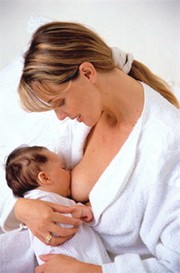Ayurveda, despite being very ancient, is a very useful science. It is based on the concept of three doshas, and describes breastfeeding through this concept as well. It teaches that the milk appearance and taste depend on the particular dosha present in it.
The breast milk is formed from the consumed food, so the foods quality affects the quality of the milk. Another important factor is the stress that can completely stop the lactation as well as change the mother’s attitude towards her child. The more a mother loves her child, the longer and more intense the breast milk production is.
Breastfeeding in Ayurveda
The individual constitution or an Ayurvedic body type of a mother also affects her milk, despite the misconception that the more the breast, the more milk is produced.
 Breast milk is considered normal if it can be easily and evenly mixed with water, it has a sweet taste and a slightly yellowish tinge.
Breast milk is considered normal if it can be easily and evenly mixed with water, it has a sweet taste and a slightly yellowish tinge.
If there is an excess of Vata dosha in the milk, its taste becomes astringent or bitter, and when coming into a contact with water it does not dissolve in it but stratifies. If a baby consumes such milk, there may be constipation, gas, abdominal pain in the form of cramps, anxiety, and sleep disorders. So the mother should follow the Ayurvedic diet for breastfeeding mothers and correct her daily routine. All foods that significantly increase Vata dosha should be excluded from the meals: cold, dry, old, bitter, astringent, overdone foods. The mother should eat 3-4 times a day (7:30 am, noon, 3:30 pm – a little bit, if she wants, and at 6:30). The time can be adjusted according to the time zone. The mother should drink enough liquid (better warm liquid), avoid snacks between meals, exclude legumes, raw cabbage, and limit the amount of apples in her meals. She should also avoid exposure to cold and drafts. No cold showers.
These recommendations are especially suitable for women of Vata, Vata-Pitta and Vata-Kapha types. Such emotions as fear, excitement, anxiety, uncertainty, pain, jealousy, talkativeness, lying, swearing, and profanity – also increase Vata in the body. A prolonged sitting in front of TV or computer also has a negative impact on the quality of your milk.
For treating a child taking such milk you can use anise, dill, caraway or fennel tea, warm baths with fir-needle or marjoram, oil enemas and soft tummy massage. Do not let your baby to be exposed to drafts, rain and cold.
If Pitta dosha is increased in milk, it becomes pungent, sour or salty. Yellow streaks appear in it if left to settle for a while. A mother with increased Pitta should take remedies to decrease this dosha. For Pitta dosha there are foods to avoid while breastfeeding according to Ayurveda: citrus, pineapple, dairy products, fried, pickled, marinated and spicy foods. No hot showers. Spend more time in open air. Avoid succumbing to anger, malice and hatred.
If a baby consumes such milk, the following conditions may develop: skin diseases, diarrhea, delay in the development of the child, pain in the abdomen. To treat the child you need to use remedies with a cooling effect. Do not wrap up your child in too warm clothes; do not use too warm water to bathe them. You can use broth of celandine, hay or birch leaves for the bath. The significant benefit for the child will come if the mother adjusts her diet to balance Pitta dosha.
If Kapha dosha is increased in the baby’s milk, it becomes very greasy, sticky, and very sweet, it has slime in it and sinks in water. If this is observed in the milk, the mother should reduce the intake of sweet, salty, fatty and starchy foods, and start doing gymnastics or any other activities that provide her with a good exercise, for example, doing yoga for Kapha dosha.
If a baby drinks the milk with increased Kapha in it, they gain weight quickly, which can lead to obesity, there may be constipation, runny nose and discharges from eyes, ears and genitals. The best treatment here is being in the open air, freedom of movement (do not diaper the baby), warm bath with a small amount of honey (two teaspoons into the bath).
If there are two doshas that dominate in the milk, use the corresponding tips for the both doshas.
The cause of the lactation reduction may be in the mother’s affirmation – she may think that she’s going to breastfeed her baby up to 5 month, for example, and then stop to avoid losing the breast form, or worsening the look of her hair and nails, etc. Just follow the healthy routine, balance your doshas, love your baby, and avoid negative thinking – your child will be growing healthy and you will be looking beautiful on and after.
These were the simple Ayurvedic tips for breastfeeding.
